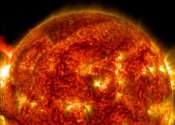The strange storms on Jupiter
At the south pole of Jupiter lurks a striking sight—even for a gas giant planet covered in colorful bands that sports a red spot larger than the earth. Down near the south pole of the planet, mostly hidden from the prying ...









